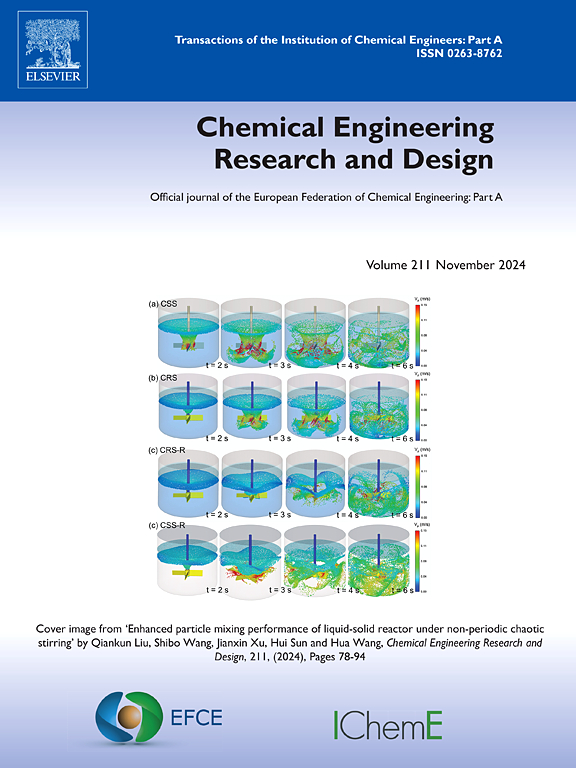Oxidative desulfurization of liquid fuels using deep eutectic solvents as a catalyst and extractant: A review
IF 3.7
3区 工程技术
Q2 ENGINEERING, CHEMICAL
引用次数: 0
Abstract
For environmental safety and sustainability, sulfur concentration in fuel must be minimized. A Commercial desulfurization method, hydrodesulfurization (HDS), offers fine desulfurization of liquid fuels; however, the major challenge of making the process energy efficient remains intact. To address this, various desulfurization approaches are being explored, such as biodesulfurization, adsorption desulfurization, extraction desulfurization, and oxidative desulfurization. Industrial engineers are finding novel reaction routes, while chemical engineers and chemists are working on preparing catalysts and their modifications to optimize process conditions. Research in oxidative desulfurization (ODS) demonstrates that both photocatalytic and thermal-driven ODS processes exhibit significant potential. Thermally driven extraction and catalytic oxidative desulfurization (ECODS) have gained attention using deep eutectic solvents (DESs) and ionic liquids (ILs) as both catalysts and extractants. However, DES overcomes certain limitations of ILs. In the case of DES, the oxidants (H2O2/O2) oxidize the organic acids in DES to peroxy acid, which in turn oxidizes sulfur compounds of fuel into easily removable sulfones, removed by the same DES (acting as extractant as well). DESs are environmentally benign, possess the capability to work synergistically with additional catalysts such as polyoxometalates (POMs) and metal-free catalysts, can be regenerated using only deionized water, and can be reused multiple times with minimal loss of efficiency. This literature review explores the synergistic, catalytic and extractive potential of DES to overcome the major challenge of energy intensive nature of desulfurization process. Furthermore, various methods are critically analyzed, comparative potential of ionic liquids and DESs in ECODS is discussed, and importance of real system (fuel) studies is emphasized.
使用深共晶溶剂作为催化剂和萃取剂对液体燃料进行氧化脱硫:综述
为了环境安全和可持续发展,必须将燃料中的硫浓度降至最低。加氢脱硫(HDS)是一种商业脱硫方法,可对液体燃料进行精细脱硫。为解决这一问题,人们正在探索各种脱硫方法,如生物脱硫、吸附脱硫、萃取脱硫和氧化脱硫。工业工程师正在寻找新的反应路线,而化学工程师和化学家则致力于制备催化剂及其改性,以优化工艺条件。氧化脱硫(ODS)方面的研究表明,光催化和热驱动 ODS 工艺都具有巨大的潜力。使用深共晶溶剂(DES)和离子液体(IL)作为催化剂和萃取剂的热驱动萃取和催化氧化脱硫(ECODS)已获得广泛关注。然而,DES 克服了离子液体的某些局限性。在 DES 的情况下,氧化剂(H2O2/O2)会将 DES 中的有机酸氧化成过氧酸,过氧酸又会将燃料中的硫化合物氧化成易于去除的砜,并由相同的 DES(同时也是萃取剂)去除。DES 对环境无害,能够与其他催化剂(如聚氧化金属(POM)和无金属催化剂)协同工作,只需使用去离子水即可再生,并且可以多次重复使用,效率损失极小。本文献综述探讨了 DES 的协同、催化和萃取潜力,以克服脱硫过程中能源密集型的主要挑战。此外,还对各种方法进行了批判性分析,讨论了离子液体和 DES 在 ECODS 中的比较潜力,并强调了实际系统(燃料)研究的重要性。
本文章由计算机程序翻译,如有差异,请以英文原文为准。
求助全文
约1分钟内获得全文
求助全文
来源期刊

Chemical Engineering Research & Design
工程技术-工程:化工
CiteScore
6.10
自引率
7.70%
发文量
623
审稿时长
42 days
期刊介绍:
ChERD aims to be the principal international journal for publication of high quality, original papers in chemical engineering.
Papers showing how research results can be used in chemical engineering design, and accounts of experimental or theoretical research work bringing new perspectives to established principles, highlighting unsolved problems or indicating directions for future research, are particularly welcome. Contributions that deal with new developments in plant or processes and that can be given quantitative expression are encouraged. The journal is especially interested in papers that extend the boundaries of traditional chemical engineering.
 求助内容:
求助内容: 应助结果提醒方式:
应助结果提醒方式:


